
An invasive species is an introduced species that harms its new environment. Invasive species adversely affect habitats and bioregions, causing ecological, environmental, and/or economic damage. The term can also be used for native species that become harmful to their native environment after human alterations to its food web. Since the 20th century, invasive species have become serious economic, social, and environmental threats worldwide.

The hobo spider is a member of the family of spiders known colloquially as funnel web spiders, but not to be confused with the Australian funnel-web spider. Individuals construct a funnel-shaped structure of silk sheeting and lie in wait at the small end of the funnel for prey insects to blunder onto their webs. Hobo spiders sometimes build their webs in or around human habitations. Despite past claims, there is no clear evidence that the hobo spider has venom that is dangerous to humans.

Agelenopsis, commonly known as the American grass spiders, is a genus of funnel weavers described by C.G. Giebel in 1869. They weave sheet webs that have a funnel shelter on one edge. The web is not sticky, but these spiders make up for that by running very rapidly. The larger specimens can grow to about 19 mm in body length. They may be recognized by the arrangement of their eight eyes into three rows. The top row has two eyes, the middle row has four eyes, and the bottom row has two eyes. They have two prominent hind spinnerets, somewhat indistinct bands on their legs, and two dark bands running down either side of the cephalothorax.
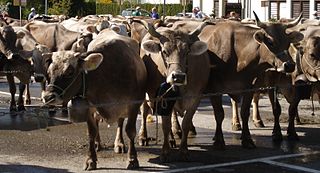
An introduced species, alien species, exotic species, adventive species, immigrant species, foreign species, non-indigenous species, or non-native species is a species living outside its native distributional range, but which has arrived there by human activity, directly or indirectly, and either deliberately or accidentally. Non-native species can have various effects on the local ecosystem. Introduced species that become established and spread beyond the place of introduction are considered naturalized. The process of human-caused introduction is distinguished from biological colonization, in which species spread to new areas through "natural" (non-human) means such as storms and rafting. The Latin expression neobiota captures the characteristic that these species are new biota to their environment in terms of established biological network relationships. Neobiota can further be divided into neozoa and neophyta (plants).
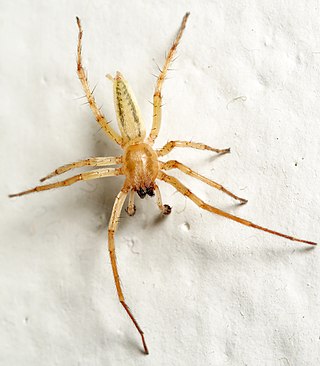
Anyphaenidae is a family of araneomorph spiders, sometimes called anyphaenid sac spiders or ghost spiders. They are distinguished from the sac spiders of the family Clubionidae and other spiders by having the abdominal spiracle placed one third to one half of the way anterior to the spinnerets toward the epigastric furrow on the underside of the abdomen. In most spiders the spiracle is just anterior to the spinnerets.

The Agelenidae are a large family of spiders in the suborder Araneomorphae. Well-known examples include the common "grass spiders" of the genus Agelenopsis. Nearly all Agelenidae are harmless to humans, but the bite of the hobo spider may be medically significant, and some evidence suggests it might cause necrotic lesions, but the matter remains subject to debate. The most widely accepted common name for members of the family is funnel weaver.

A synanthrope is an organism that lives near and benefits from humans and their environmental modifications. The term synanthrope includes many species regarded as pests or weeds, but does not include domesticated animals. Common synanthrope habitats include houses, gardens, farms, parks, roadsides and rubbish dumps.

Lantana camara is a species of flowering plant in the verbena family (Verbenaceae), native to the American tropics. It is a very adaptable species, which can inhabit a wide variety of ecosystems; once it has been introduced into a habitat it spreads rapidly; between 45ºN and 45ºS and less than 1,400 metres in altitude.
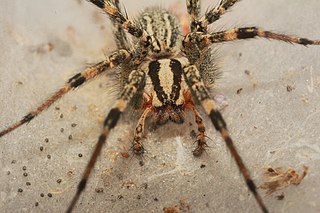
Agelenopsis aperta, also known as the desert grass spider or funnel-web spider, is a species of spider belonging to the family Agelenidae and the genus Agelenopsis. It is found in dry and arid regions across the southern United States and into northwestern Mexico. Their body is about 13–18 mm long and they have relatively long legs in order to run after their prey. Desert grass spiders can withstand very low temperatures even though they do not cold harden. It constructs the characteristic funnel-shaped webs in crevices where the funnel will fit, where they wait in the tube for prey which they can run after using their long legs. They often hunt for their prey at night.

The Makauwahi Cave is the largest limestone cave found in Hawaii. It lies on the south coast of the island of Kauaʻi, in the Māhāʻulepū Valley close to Māhāʻulepū Beach, and is important for its paleoecological and archaeological values. It is reached via a sinkhole and has been described as “…maybe the richest fossil site in the Hawaiian Islands, perhaps in the entire Pacific Island region”.
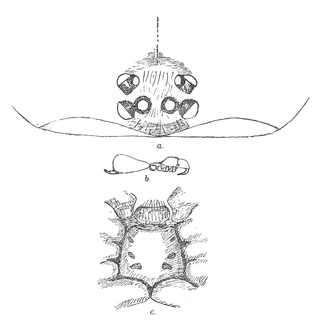
Cantuaria is a genus of South Pacific armored trapdoor spiders that was first described by Henry Roughton Hogg in 1902. From 1985 to 2006 it was merged with former genus Misgolas, now Arbanitis.
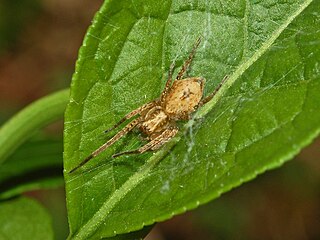
Anyphaena is a genus of anyphaenid sac spiders first described by Carl Jakob Sundevall in 1833.
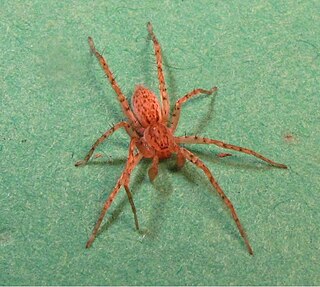
Anyphaena fraterna is a species of ghost spider in the family Anyphaenidae. It is found in the USA.
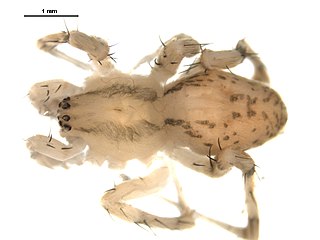
Anyphaena pectorosa is a species of ghost spider in the family Anyphaenidae. It is found in the United States and Canada.
Anyphaena californica is a species of ghost spider in the family Anyphaenidae. It is found in the United States.

Anyphaena pacifica is a species of ghost spider in the family Anyphaenidae. It is found in the United States and Canada.
Anyphaena dixiana is a species of ghost spider in the family Anyphaenidae. It is found in the United States.
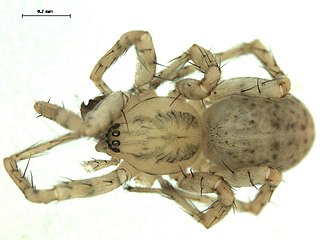
Anyphaena celer is a species of ghost spider in the family Anyphaenidae. It is found in the United States and Canada.

Anyphaena accentuata is a species of spider in the Order Araneae.


















